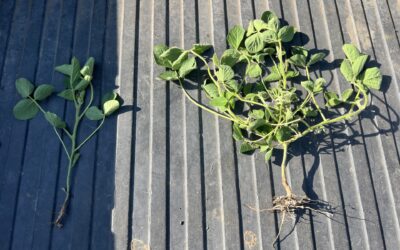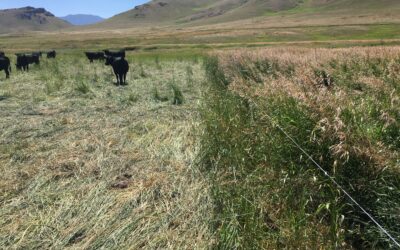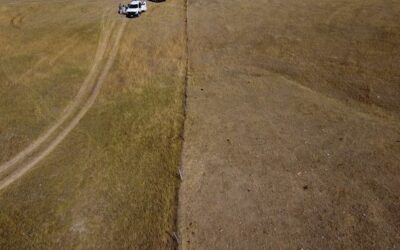Microorganisms
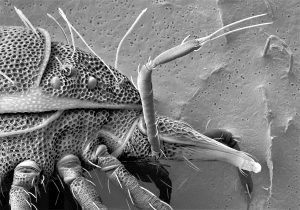 Microorganisms are very small forms of life that can sometimes live as single cells, although many also form colonies of cells. A microscope is usually needed to see individual cells of these organisms. Many more microorganisms exist in topsoil, where food sources are plentiful, than in subsoil. They are especially abundant in the area immediately next to plant roots (called the rhizosphere), where sloughed-off cells and chemicals released by roots provide ready food sources. These organisms are primary decomposers of organic matter, but they do other things, such as provide nitrogen through fixation to help growing plants, detoxify harmful chemicals (toxins), suppress disease organisms, and produce products that might stimulate plant growth. Soil microorganisms have had another direct importance for humans—they are the source of most of the antibiotic medicines we use to fight diseases.
Microorganisms are very small forms of life that can sometimes live as single cells, although many also form colonies of cells. A microscope is usually needed to see individual cells of these organisms. Many more microorganisms exist in topsoil, where food sources are plentiful, than in subsoil. They are especially abundant in the area immediately next to plant roots (called the rhizosphere), where sloughed-off cells and chemicals released by roots provide ready food sources. These organisms are primary decomposers of organic matter, but they do other things, such as provide nitrogen through fixation to help growing plants, detoxify harmful chemicals (toxins), suppress disease organisms, and produce products that might stimulate plant growth. Soil microorganisms have had another direct importance for humans—they are the source of most of the antibiotic medicines we use to fight diseases.
Bacteria
Bacteria live in almost any habitat. They are found inside the digestive system of animals, in the ocean and fresh water, in compost piles (even at temperatures over 130°F), and in soils. Although some kinds of bacteria live in flooded soils without oxygen, most require well-aerated soils. In general, bacteria tend to do better in neutral pH soils than in acid soils.
In addition to being among the first organisms to begin decomposing residues in the soil, bacteria benefit plants by increasing nutrient availability. For example, many bacteria dissolve phosphorus, making it more available for plants to use. Bacteria are also very helpful in providing nitrogen to plants, which they need in large amounts but is often deficient in agricultural soils. You may wonder how soils can be deficient in nitrogen when we are surrounded by it—78% of the air we breathe is composed of nitrogen gas. Yet plants as well as animals face a dilemma similar to that of the Ancient Mariner, who was adrift at sea without fresh water: “Water, water, everywhere nor any drop to drink.” Unfortunately, neither animals nor plants can use nitrogen gas (N2) for their nutrition. However, some types of bacteria are able to take nitrogen gas from the atmosphere and convert it into a form that plants can use to make amino acids and proteins. This conversion process is known as nitrogen fixation.
Some nitrogen-fixing bacteria form mutually beneficial associations with plants. One such symbiotic relationship that is very important to agriculture involves the nitrogen-fixing rhizobia group of bacteria that live inside nodules formed on the roots of legumes. These bacteria provide nitrogen in a form that leguminous plants can use, while the legume provides the bacteria with sugars for energy.
People eat some legumes or their products, such as peas, dry beans, and tofu made from soybeans. Soybeans, alfalfa, and clover are used for animal feed. Clovers and hairy vetch are grown as cover crops to enrich the soil with organic matter, as well as nitrogen, for the following crop. In an alfalfa field, the bacteria may fix hundreds of pounds of nitrogen per acre each year. With peas, the amount of nitrogen fixed is much lower, around 30 to 50 pounds per acre.
The actinomycetes, another group of bacteria, break large lignin molecules into smaller sizes. Lignin is a large and complex molecule found in plant tissue, especially stems, that is difficult for most organisms to break down. Lignin also frequently protects other molecules like cellulose from decomposition. Actinomycetes have some characteristics similar to those of fungi, but they are sometimes grouped by themselves and given equal billing with bacteria and fungi.
Fungi
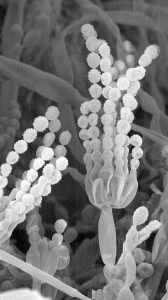 Fungi are another type of soil microorganism. Yeast is a fungus used in baking and in the production of alcohol. Other fungi produce a number of antibiotics. We have all probably let a loaf of bread sit around too long only to find fungus growing on it. We have seen or eaten mushrooms, the fruiting structures of some fungi. Farmers know that fungi cause many plant diseases, such as downy mildew, damping-off, various types of root rot, and apple scab. Fungi also initiate the decomposition of fresh organic residues. They help get things going by softening organic debris and making it easier for other organisms to join in the decomposition process. Fungi are also the main decomposers of lignin and are less sensitive to acid soil conditions than bacteria. None are able to function without oxygen. Low soil disturbance resulting from reduced tillage systems tends to promote organic residue accumulation at and near the surface. This tends to promote fungal growth, as happens in many natural undisturbed ecosystems.
Fungi are another type of soil microorganism. Yeast is a fungus used in baking and in the production of alcohol. Other fungi produce a number of antibiotics. We have all probably let a loaf of bread sit around too long only to find fungus growing on it. We have seen or eaten mushrooms, the fruiting structures of some fungi. Farmers know that fungi cause many plant diseases, such as downy mildew, damping-off, various types of root rot, and apple scab. Fungi also initiate the decomposition of fresh organic residues. They help get things going by softening organic debris and making it easier for other organisms to join in the decomposition process. Fungi are also the main decomposers of lignin and are less sensitive to acid soil conditions than bacteria. None are able to function without oxygen. Low soil disturbance resulting from reduced tillage systems tends to promote organic residue accumulation at and near the surface. This tends to promote fungal growth, as happens in many natural undisturbed ecosystems.
Many plants develop a beneficial relationship with fungi that increases the contact of roots with the soil. Fungi infect the roots and send out root-like structures called hyphae (see figure 4.2). The hyphae of these mycorrhizal fungi take up water and nutrients that can then feed the plant. The hyphae are very thin, about 1/60 the diameter of a plant root, and are able to exploit the water and nutrients in small spaces in the soil that might be inaccessible to roots. This is especially important for phosphorus nutrition of plants in low-phosphorus soils. The hyphae help the plant absorb water and nutrients, and in return the fungi receive energy in the form of sugars, which the plant produces in its leaves and sends down to the roots. This symbiotic interdependency between fungi and roots is called a mycorrhizal relationship. All things considered, it’s a pretty good deal for both the plant and the fungus. The hyphae of these fungi help develop and stabilize larger soil aggregates by secreting a sticky gel that glues mineral and organic particles together.
Algae
Algae, like crop plants, convert sunlight into complex molecules like sugars, which they can use for energy and to help build other molecules they need. Algae are found in abundance in the flooded soils of swamps and rice paddies, and they can be found on the surface of poorly drained soils and in wet depressions. Algae may also occur in relatively dry soils, and they form mutually beneficial relationships with other organisms. Lichens found on rocks are an association between a fungus and an alga.
Protozoa
Protozoa are single-celled animals that use a variety of means to move about in the soil. Like bacteria and many fungi, they can be seen only with the help of a microscope. They are mainly secondary consumers of organic materials, feeding on bacteria, fungi, other protozoa, and organic molecules dissolved in the soil water. Protozoa—through their grazing on nitrogen-rich organisms and excreting wastes—are believed to be responsible for mineralizing (releasing nutrients from organic molecules) much of the nitrogen in agricultural soils.
This Page Was Created Utilizing Text And Images From These Sources:
Sustainable Agriculture Research & Education Learning Center, Soil Microorganisms Page
Natural Resources Conservation Service Soil Health Campaign Flickr Account
Photo Credit: USDA-ARS, Electron & Confocal Microscopy Unit, Beltsville, MD USA
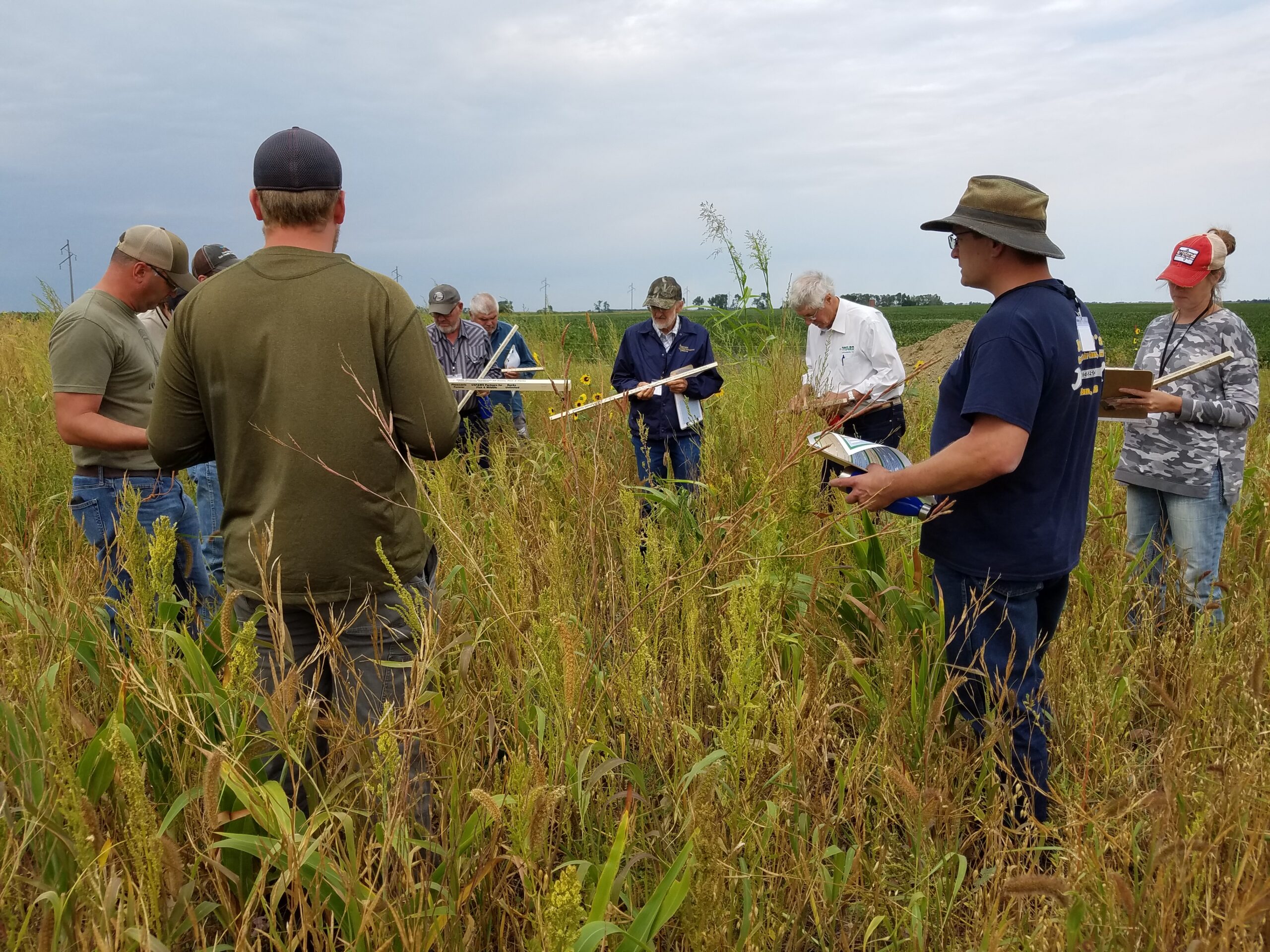
West River Soil Health School Registration Open!
In 2024, the South Dakota Soil Health Coalition will host an additional Soil Health School in west of the Missouri River! The 2024 West River Soil Health School with be held June 26-27 near Caputa, SD! This school will focus on issues specific to the land, climate, and ag production systems of wester South Dakota. Class size is limited, so early registration is strongly encouraged!
News & Events
Farmer reaps higher yields by interseeding soybeans
By Stan Wise Alex Frasier has spent a lot of time studying what it takes to grow a successful crop. After studying ag production and precision technology at Lake Area Technical College, he has worked in ag retail and currently works as an agronomist in Aberdeen, SD....
Farm and ranch innovators to share new ideas at Soil Health Conference
By Stan Wise PIERRE, SD — Before Cooper Hibbard came home to manage his family’s ranch, he studied ag business, rangeland resources and Spanish at California Polytechnic State University and then worked on ranches all over the world. That education and experience...
Wintertime is decision time
By Stan Wise PIERRE, SD – It’s often said that the best time to start improving your land was 20 years ago, but the second-best time is right now. That statement might be harder for ranchers to swallow with winter on their doorstep, nothing growing in their pastures,...
